Written By: Mark Neff, President & CEO of Forsyth Humane Society

In the bustling, heartwarming, yet often heart-wrenching world of animal welfare, communication is both a beacon of hope and a challenge to surmount. As President and CEO of Forsyth Humane Society, I’ve navigated the diverse currents of communication that flow between our staff, volunteers, foster network, board of directors, finance and marketing teams, and executive committees, as well as the public. Each group brings its own dialect of passion, concern, and vision to the collective table, making effective communication a necessity and a lifeline to our mission’s success.
The Emotional Landscape
The first hurdle in our communication journey is the deeply emotional nature of our work. Animals, by their very essence, evoke strong emotions from people. The stories of rescue, rehabilitation, and sometimes loss we share can profoundly affect our team members and the public. Communicating in such a charged atmosphere requires a delicate balance: we must be empathetic, supportive, clear, and decisive. It’s a dance of conveying hard truths with compassion, celebrating victories without complacency, and always advocating for our non-human friends’ welfare.
Diverse Communication Styles
Our organization is a tapestry of individuals, each with their own communication style. Staff may prefer direct, concise updates, while volunteers resonate more with stories and emotional connections. On the other hand, the board of directors and executive committees often seek detailed reports and strategic plans. Bridging these styles requires a multifaceted approach, utilizing a mix of formal presentations, heartfelt storytelling, and open forums for dialogue. The key is knowing your audience and tailoring your message to ensure it reaches and resonates with them.
Public Perceptions and Challenges
Engaging with the public presents its own set of challenges. The passionate nature of animal welfare means that public opinions are solid and varied. Misunderstandings can quickly escalate, and well-intentioned actions can sometimes be misconstrued. To navigate this, we prioritize transparency and education in our communications. Social media, press releases, and public events become tools not just for sharing our successes but for opening lines of communication, educating the public about the complexities of animal welfare, and inviting dialogue rather than dissent.
Inter-Organizational Dynamics
Another dimension of our communication landscape involves interactions with other animal welfare organizations. Unfortunately, not all dialogues are supportive or constructive. Criticism and negative commentary can emerge, driven by differing philosophies or resource competition. To overcome these challenges, we focus on collaboration over confrontation. We seek common ground and mutual respect by emphasizing shared goals and the overarching mission of animal welfare. When faced with negativity, we respond with professionalism and a steadfast commitment to our principles, often turning potential conflicts into opportunities for partnership and growth.
The Path Forward
As we continue to evolve and grow, effective communication becomes increasingly critical. It’s about more than just sharing information; it’s about building relationships, fostering understanding, and creating a community united in its commitment to animal welfare. By embracing the complexities of our communication challenges, we strengthen not just our organization but the very fabric of the animal welfare community.
At Forsyth Humane Society, we are committed to refining our communication strategies, always with an eye toward empathy, clarity, and unity. In doing so, we enhance our ability to care for animals in need and inspire others to join us in this vital, compassionate work. Together, through the power of effective communication, we can navigate any challenge and turn our shared vision for animal welfare into a reality.

